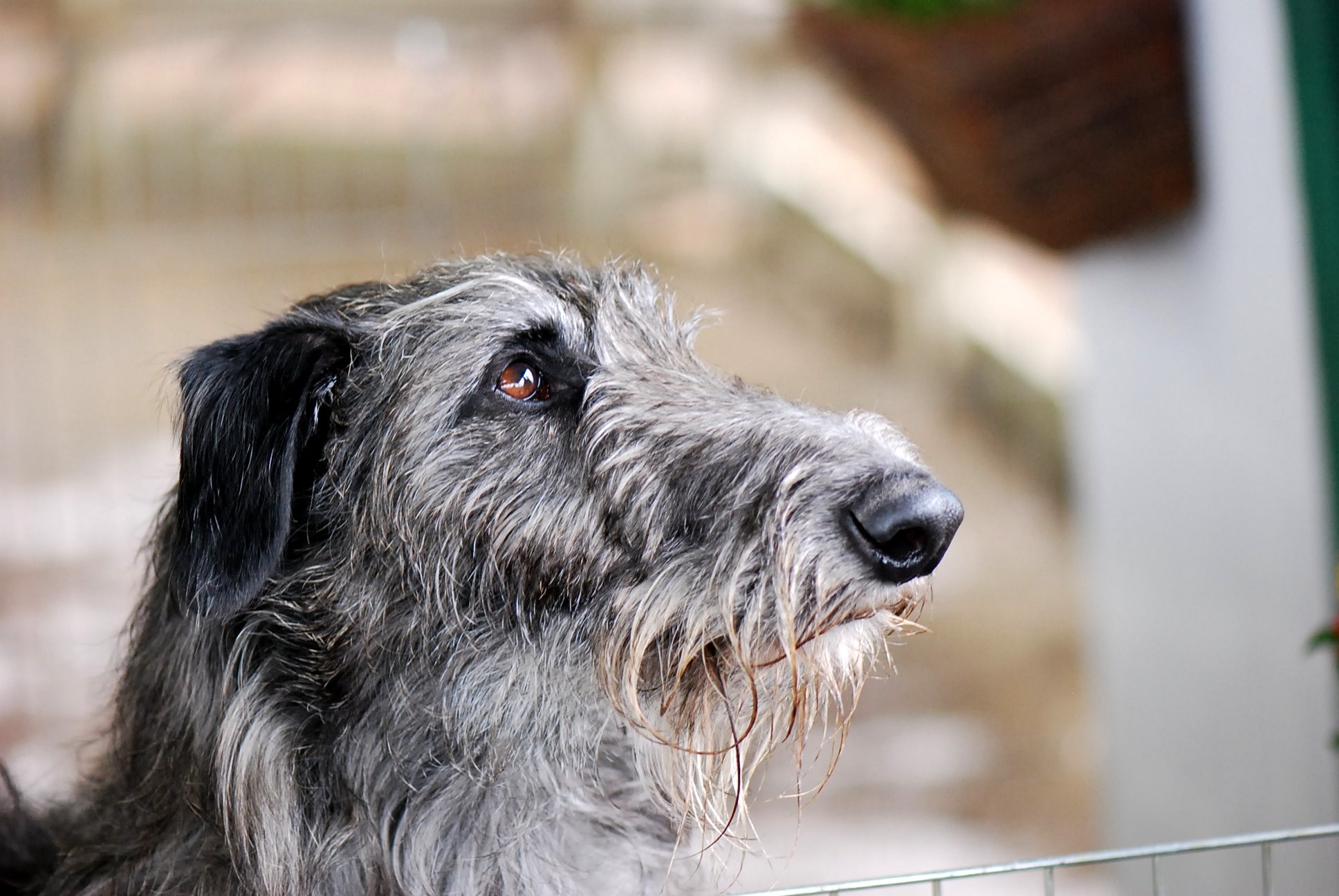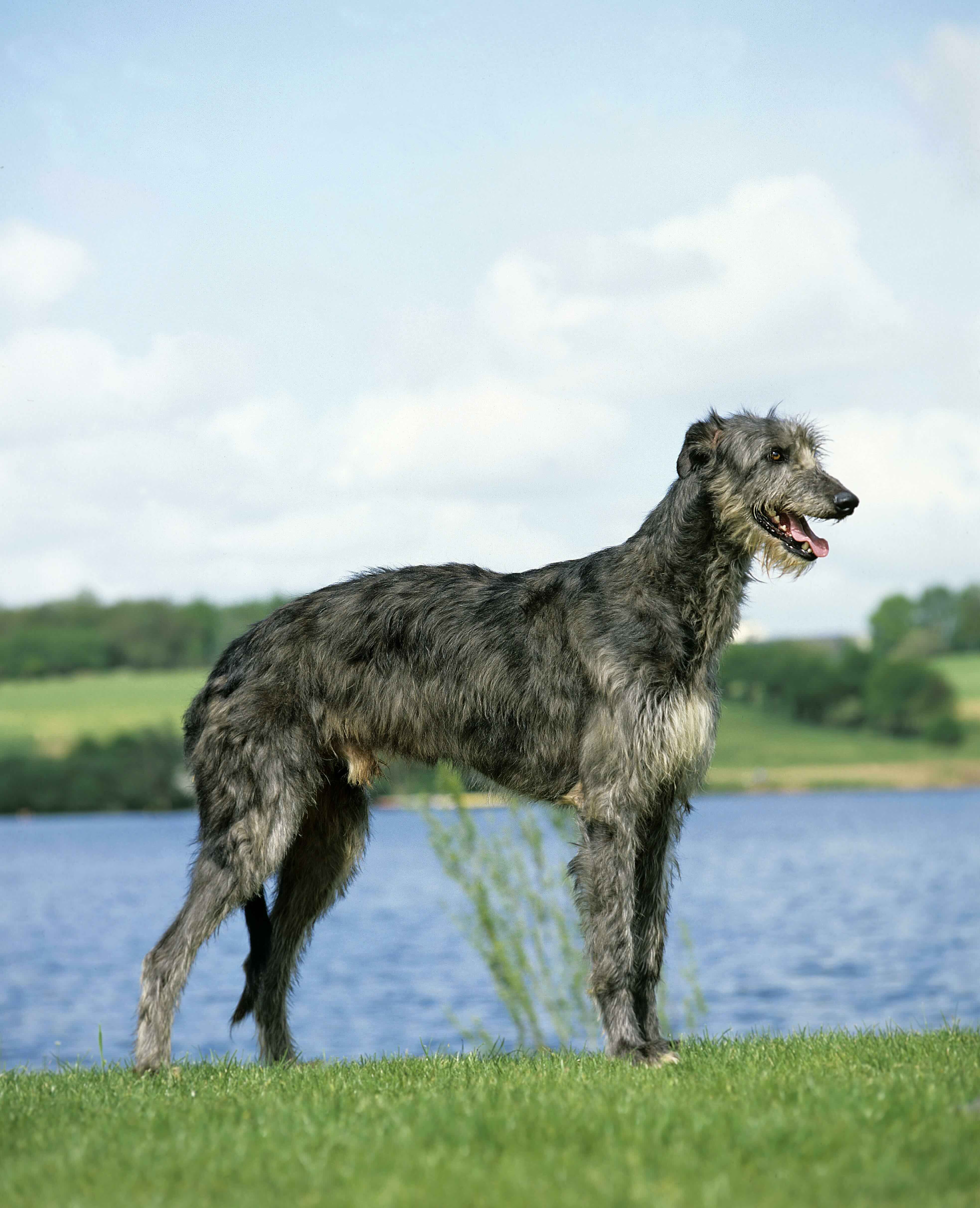Scottish Deerhound
Adobe Stock/zwierzokadr
The Scottish Deerhound is a tall and statuesque breed from Scotland. The breed’s modern origins date back as early as the 1500s, when these dogs were bred to hunt deer across the Scottish Highlands. Today, they are best known for being gentle giants at home.
The Deerhound, as the breed is often called, is a sight hound that shares a wiry coat similar to the Irish Wolfhound and a lanky build like the Greyhound. They are one of the biggest dog breeds; when full-grown, a Scottish Deerhound stands 28–32 inches at the shoulder and weighs 75–110 pounds.
Caring for a Scottish Deerhound
Scottish Deerhounds typically make excellent companions if you can meet their specific needs.
Generally speaking, the Scottish Deerhound temperament is easygoing, but they are also independent thinkers, and therefore require patience and persistence when it comes to training. As an athletic sight hound, expect to spend at least one hour (or more) each day exercising this breed—it’s essential for the dog’s mental and physical well-being.
As for grooming, Scottish Deerhounds are relatively easy. Their coarse coat requires a weekly brushing and occasional bath.
Scottish Deerhound Health Issues

The Scottish Deerhound lifespan is shorter than what you might expect due to their massive size. On average, these dogs live 8–11 years. They are also predisposed to several health issues, and pet insurance may be a worthwhile investment.
The most important thing you can do to keep your dog healthy is educate yourself on the most common Scottish Deerhound health issues and keep up with routine veterinary exams. If you’re able, find a veterinarian who’s experienced with the breed.
Dilated Cardiomyopathy
Like a few other giant dog breeds, the Scottish Deerhound is prone to an enlarged heart, known as dilated cardiomyopathy (DCM). This condition makes it more challenging for the heart to effectively pump blood to the rest of the body.
Be alert for symptoms of heart problems, including an intolerance for exercise, rapid breathing, and restlessness. DCM can turn into congestive heart failure, which can be fatal.
Grain-free dog foods, especially those that contain peas, have been associated with the development of DCM in dogs like the Scottish Deerhound. Always talk to your veterinarian to find the best food for your dog.
Osteosarcoma (Bone Cancer)
Scottish Deerhounds have a genetic risk factor for developing osteosarcoma, a type of cancer that originates in bone cells. In a giant dog like the Deerhound, tumors usually develop on the legs, but the cancer’s aggressive spread to other organs is also common.
Early detection and diagnosis can improve the odds of successful treatment, which often includes amputation of the affected limb and/or chemotherapy.
Bloat and Gastric Dilation-Volvulus (GDV)
The Scottish Deerhound’s deep chest makes the breed susceptible to bloat, a condition where the stomach expands due to gas and food. Sometimes bloat progresses to gastric dilation-volvulus, where the stomach twists and cuts off blood to important internal organs.
GDV is a life-threatening emergency, and dogs exhibiting symptoms must see an emergency veterinarian immediately for treatment.
Signs of GDV include:
-
An enlarged abdomen
-
Decreased appetite
-
Restlessness
-
Gagging and retching without producing vomit
A gastropexy procedure during your dog’s spay or neuter surgery can prevent GDV from occurring later.
What To Feed a Scottish Deerhound

Feed your Scottish Deerhound a high-quality dog food formulated for large or giant breeds. The food must meet the nutritional guidelines set by the Association of American Feed Control Officials (AAFCO) and be formulated for your dog’s current life stage (puppy, adult, or senior).
How To Feed a Scottish Deerhound
An adult Scottish Deerhound should be fed two meals a day—usually in the morning and evening. Scottish Deerhound puppies need a puppy formula made for large breeds, ideally three to four times each day to ensure proper development. Fresh water should always be available to your dog.
To reduce the chance of bloat in your dog, take precautions during mealtimes:
-
Feed your Scottish Deerhound from a slow-feeder bowl or puzzle toy
-
Avoid exercising your dog directly before or after they eat
-
Don’t use elevated food bowls
How Much Should You Feed a Scottish Deerhound?
To determine how much to feed a Scottish Deerhound, start by reading the feeding guidelines on the dog food formula you choose. This gives you a general amount to feed your dog based on their weight.
Your veterinarian can provide specific guidance on how much to feed your dog based on factors unique to your Deerhound.
Nutritional Tips for Scottish Deerhounds
When feeding your Scottish Deerhound an AAFCO-approved diet, they are likely getting all necessary nutrients to support good health. However, your veterinarian may recommend specific supplements for your dog, depending on their health risks.
Never give your dog a supplement without speaking with your vet first.
Behavior and Training Tips for Scottish Deerhounds
Scottish Deerhound Personality and Temperament

Betty Stephenson, a longtime breeder and member of the Scottish Deerhound Club of America (SDCA), describes the Scottish Deerhound temperament as gentle and friendly. While some diversity in personality is to be expected, she says nearly all Deerhounds enjoy a good nap.
“Some are aloof, some are more ebullient,” Stephenson says. “But once fully mature, most spend the better part of the day asleep on the couch or your bed.”
Like all dog breeds, proper socialization is important for establishing positive dynamics between a Scottish Deerhound and other people, pets, and children.
The breed’s strong prey drive means extra vigilance may be needed with smaller household pets, like cats. This is especially true in outdoor settings, where the tendency to chase animals can be especially strong.
Scottish Deerhound Behavior
These calm dogs are more laid-back than many other dog breeds, though Scottish Deerhounds still need at least 30 minutes of exercise twice a day to stay healthy.
“All sight hounds, by average dog standards, are low-energy,” says Lynne Bruce, an SDCA member who has raised and showed Scottish Deerhounds for nearly 50 years. “They seem to only have two speeds: sound asleep on the couch or streaking around the property!”
Though adult Deerhounds are more low-key, puppies and adolescents can be challenging, Bruce says.
“They are big and strong, and can be destructive during this phase,” she says. “[But] by the time they are 2, they have grown out of that and you couldn't get a better companion; they are gentle and loyal, and so easy to live with.”
Scottish Deerhound Training
Scottish Deerhounds are smart dogs and can easily learn training cues. The more challenging part is motivating the dog to follow your request. “They do not have an overwhelming desire to please you, but they will work for you because they have a close bond with you, so it is more of an equal partnership,” says Bruce.
To effectively train a Scottish Deerhound, it helps to keep in mind the breed’s working heritage. In comparison to sporting, herding, and working breeds that are focused on pleasing their pet parent in any task, “the hounds were bred to work away from you and independently, so checking back to see whether you approve, as other breeds do, is rare in Deerhounds,” says Stephenson.
With that in mind, don’t mistake a Deerhound’s independence for willfulness. Positive reinforcement is the key to unlocking a Scottish Deerhound’s obedience. In addition, it’s a good idea to introduce variety into your training routine.
“Deerhounds are smart and catch on quickly,” Bruce says, “but they do get bored easily if it is not a challenging enough task for them.”
Fun Activities for Scottish Deerhounds
-
Nose work
-
FastCAT
Scottish Deerhound Grooming Guide

Scottish Deerhounds have a 3- to 4-inch-long double coat made of a wiry topcoat and soft undercoat. This keeps the breed dry and protected—a helpful attribute in the wet weather of their native Scottish Highlands.
Today, the length and texture of the dog’s coat may vary. Regardless, Scottish Deerhounds don’t require much grooming beyond a weekly brushing and an occasional bath.
Skin Care
The double coat protects the skin of the Scottish Deerhound very well, and these dogs don’t require frequent bathing, either. A bath is only necessary when a Deerhound is very dirty or muddy.
Coat Care
Although the wiry coat resists matting, regular brushing is a good practice to reduce dead hair and to distribute the coat’s natural oils. Plan on brushing your Scottish Deerhound about once a week—perhaps more often if the coat picks up debris from walking through tall grass or the woods.
Keep in mind that since coat type varies among Scottish Deerhounds, each dog’s individual coat care needs can vary as well. Stephenson says Deerhounds with a thinner coat are the easiest to care for, while more heavily coated Deerhounds will need more regular attention.
No matter your Scottish Deerhound’s coat, “the coarse and wiry nature of the coat does tend to be easier either way to care for than softer and more heavily coated breeds,” Stephenson says.
Eye Care
It’s a good practice to regularly check your dog’s eyes and eyelids for signs of cloudiness or infection.
In addition, the Scottish Deerhound tends to have long and wispy hairs around the face, including along the brow. An occasional trim might be needed to keep hair from disrupting the dog’s vision or causing irritation.
Ear Care
Do not overlook ear care as part of the Scottish Deerhound’s regular grooming routine. Check their ears regularly for signs of an ear infection, and contact your veterinarian if you notice anything concerning.
Considerations for Pet Parents
It’s hard to resist the appeal of the Scottish Deerhound, a gentle giant with a graceful and kind nature.
However, it’s important for pet parents not to overlook the demands that come from training and exercising sight hounds. This is even more true for first-time dog parents; in that case, Bruce suggests that it may be easier to start with a breed that has less specialized needs than a sight hound.
When properly trained and mature, a Scottish Deerhound makes a very dignified house companion. And while the breed has a somewhat short lifespan, they are easy keepers in terms of grooming requirements, and they’re patient with children and generally friendly with people.
Scottish Deerhound FAQs
Which is bigger, the Irish Wolfhound or the Scottish Deerhound?
The Irish Wolfhound is larger than the Scottish Deerhound. The Irish Wolfhound is usually an inch or two taller at the shoulders and weighs more.
Is the Scottish Deerhound a good pet?
Yes. As long as you have the time and energy to devote to regular exercise and the patience to train an independent dog, the Scottish Deerhound can make a very good pet. These dogs are considered to be very easygoing once they mature.
Do Scottish Deerhounds shed a lot?
No, the wiry coat of the Scottish Deerhound sheds minimally. Regular brushing once or twice per week with a slicker brush can help to remove dead hairs that would otherwise wind up on your floors or furniture.
Do Scottish Deerhounds need a lot of exercise?
While the docile nature of the Scottish Deerhound might fool you into thinking that these dogs have minimal exercise needs, it’s not the case. “Adult Deerhounds can be extremely lazy, but they cannot be healthy without a lot of exercise,” says Stephenson. “Most love a long run at least once a day and really need it more than once.”
